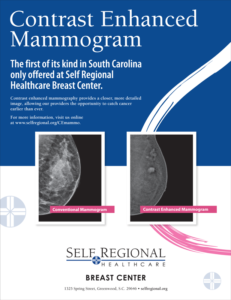Contrast enhanced mammography (CEM) has been shown to detect cancers that may not be visible on a mammogram. CEM is performed following a mammogram and/or an ultrasound exam to learn more about an area that looks abnormal or potentially abnormal.
Early Detection
Doctors and scientists agree that early detection is the best defense against breast cancer. Successful treatment and survival rates for breast cancer patients are dramatically affected by early detection. If breast cancer is found early, before it has spread to the lymph nodes, the five-year survival rate is almost 100 percent.
What is contrast enhanced mammography?
A contrast enhanced mammography examination provides additional information beyond a conventional mammogram, and may result in earlier detection of some cancers, similar to diagnostic breast MRI.
Contrast enhanced mammography refers to the imaging of a drug, known as a contrast agent, using mammographic imaging equipment. The contrast agents are the same as ones typically used in standard computerized tomography examinations (commonly known as CAT scans).
How does contrast enhanced mammography work?
Contrast agents have been shown to accumulate in areas of the breast where cancers may be forming or growing. A contrast enhanced mammography exam will help identify areas where the contrast agent is accumulating.
What to expect during your exam
A contrast enhanced mammography examination is very similar to having a conventional mammogram. Prior to the exam, the physician will inject the contrast agent into your arm while you are relaxed. After the injection, you will wait two minutes to allow the contrast agent to flow into your breast.
After two minutes, the technologist will perform one or more conventional mammograms on the specific breast(s) of interest. The physician will then review the images to ensure that they have captured the appropriate information. The physician will also study the images to determine whether there are accumulations of the contrast agent in specific areas of the breast.
Will there be additional compression?
There is no additional compression required other than what is generally required for a conventional mammogram.

